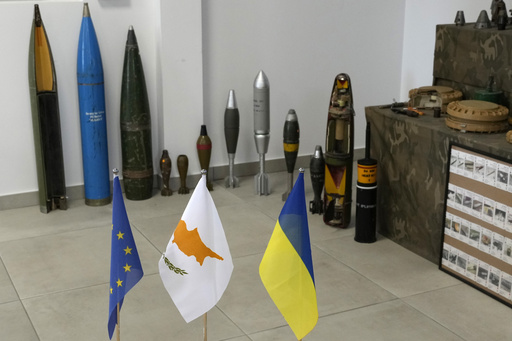
In a National Guard facility in Cyprus, Ukrainian individuals are currently receiving training aimed at the identification, location, and disposal of landmines and unexploded ordnance that are widespread in their homeland, posing a threat to countless lives including those of children.
The ongoing war with Russia has rendered Ukraine one of the most severely impacted nations in terms of landmine hazards and abandoned explosives.
United Nations statistics reveal that since the onset of Russia’s full-scale invasion on February 24, 2022, approximately 399 fatalities and 915 injuries have occurred due to landmines and other explosive devices, a figure that mirrors casualties reported between 2014 and 2021.
Alarmingly, over 10% of these victims are children.
Additionally, the economic costs associated with these dangers are immense, with landmines obstructing agricultural activities over 5 million hectares, equating to roughly 10% of Ukraine’s farmland.
Cyprus has stepped forward to provide its training facilities as part of the European Union’s Military Assistance Mission to Ukraine.
Nearly 100 personnel from the Ukrainian armed forces have completed three cycles of training over the past two years, according to a representative from the Cyprus Foreign Ministry, Theodoros Gotsis.
Gotsis expressed the nation’s ongoing commitment to support Ukraine, adding that the training initiative has cost roughly 250,000 euros (about $262,600) which was covered by the Cypriot government.
This training initiative draws upon Cyprus’s own historical challenges with landmines, stemming from conflicts that began five decades ago, when the island faced ethnic division following a Turkish invasion triggered by a coup aimed at unifying with Greece.
While the United Nations has successfully removed about 27,000 landmines from a buffer zone bisecting Cyprus, minefields still exist on both sides.
According to the Cypriot government, it has adhered to its international obligations by eliminating all anti-personnel mines.
Participants in the training undergo comprehensive theoretical and practical instruction through a five-week Basic Demining and Clearance course.
This course focuses on the safe handling of various types of explosives, including rockets, artillery shells, and grenades.
The theoretical components utilize inert munitions that are identical in appearance to real explosives, allowing trainees to develop the necessary skills without risk.
A significant portion of the training is dedicated to hands-on practice, which involves the actual destruction of unexploded munitions with explosives as part of the curriculum.
A senior training officer, who requested anonymity for security reasons, detailed that this practical application is critical for the trainees who will return home to perform ordnance disposal tasks.
Due to safety considerations, the course does not cover scenarios where explosives cannot be safely deployed, such as locations near hospitals, which are managed by specialized disposal experts that undergo training that can extend to eight months.
Divided into small groups, trainees learn to operate metal detectors and tools designed for locating explosives, including long, flexible rods used to probe the ground for mines and ordnance.
Another instrument, known as a feeler, is utilized to identify booby-trapped munitions, highlighting the complex challenges faced in Ukraine where such traps are increasingly common.
Training sessions are conducted primarily by experts from various EU member states and take place in both wooded and urban settings within different military camps, adhering to stringent safety measures.
The short and focused nature of the training has kept participants highly engaged, as noted by the chief training officer, who observed their eagerness to learn and rectify any errors made during the instruction sessions.
A report from ACAPS published in January 2024 indicated that approximately 174,000 square kilometers (67,182 square miles), or nearly 29% of Ukraine, requires landmine and ordnance surveys.
This translates to more than 10 million residents living in areas identified as needing demining efforts.
Since 2022, Russian forces have utilized at least 13 distinct types of anti-personnel mines, which are particularly harmful to civilians.
Although Russia has not ratified the 1997 Ottawa Convention that prohibits the use of anti-personnel mines, such actions are considered breaches of international law.
Additionally, reports indicate Russia’s deployment of 13 types of anti-tank mines.
Furthermore, the International Campaign to Ban Landmines revealed that Ukrainian forces may have employed anti-personnel mines around the city of Izium in 2022, during the period of Russian control, thereby contravening the Mine Ban Treaty.
